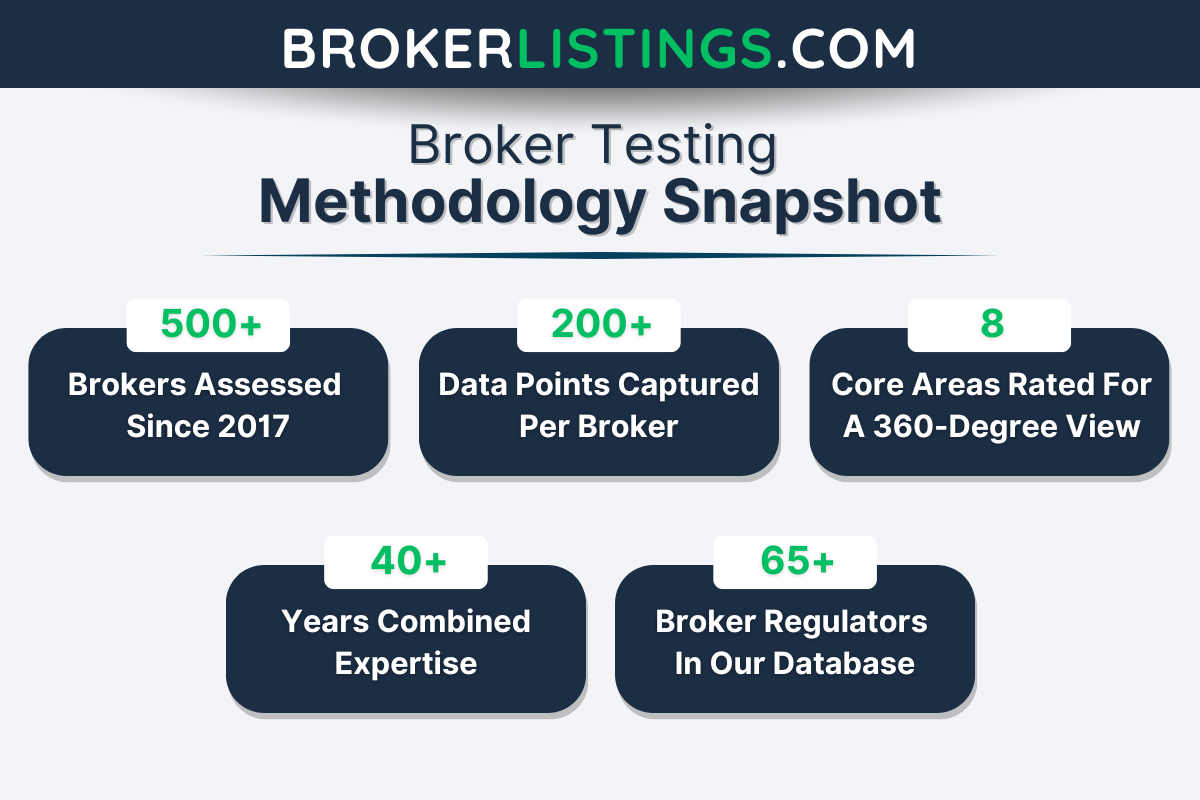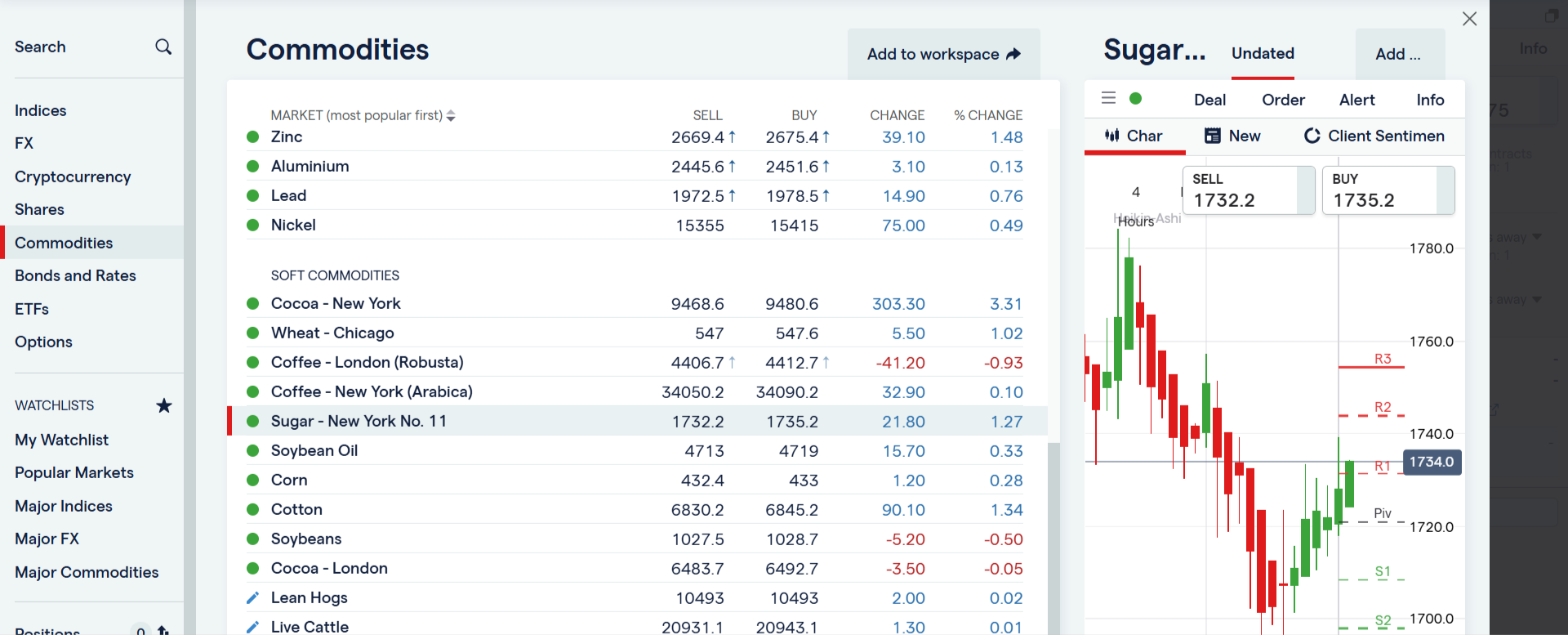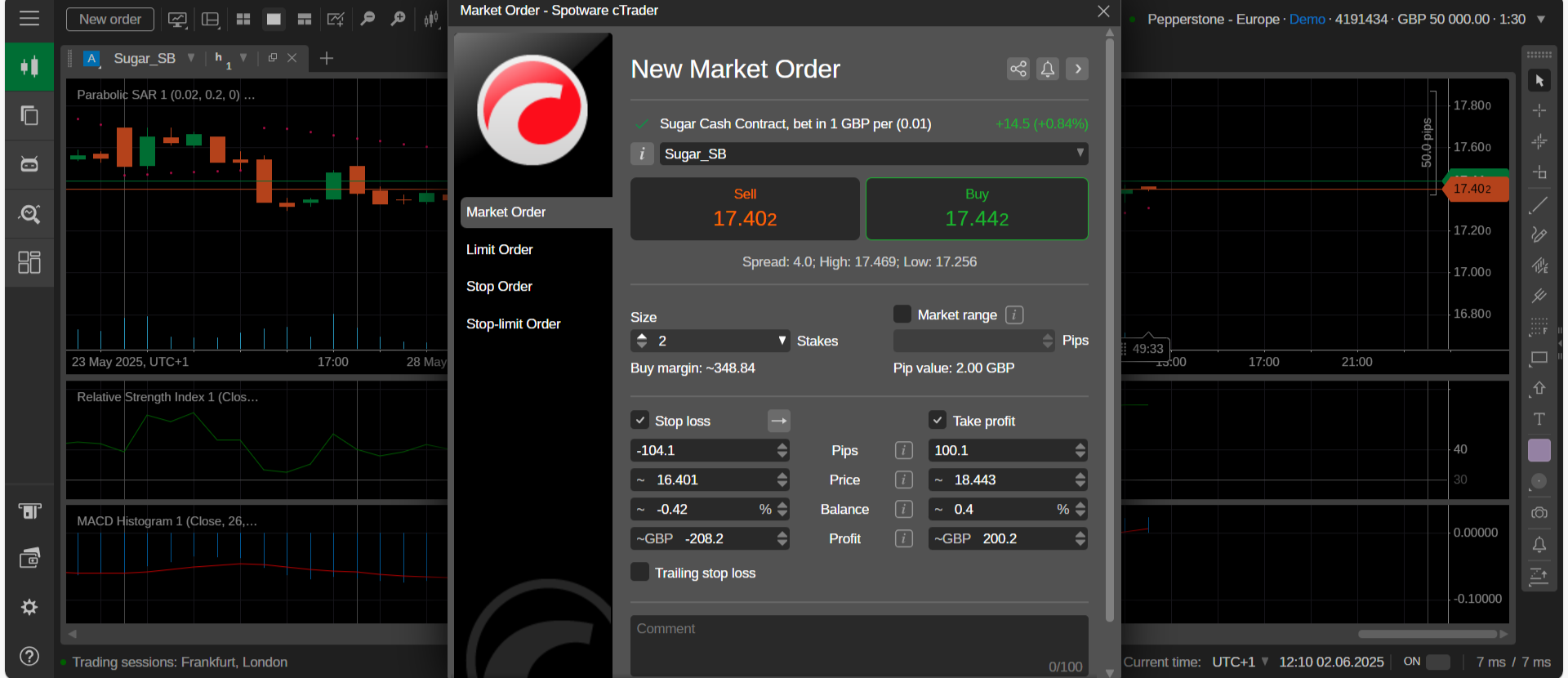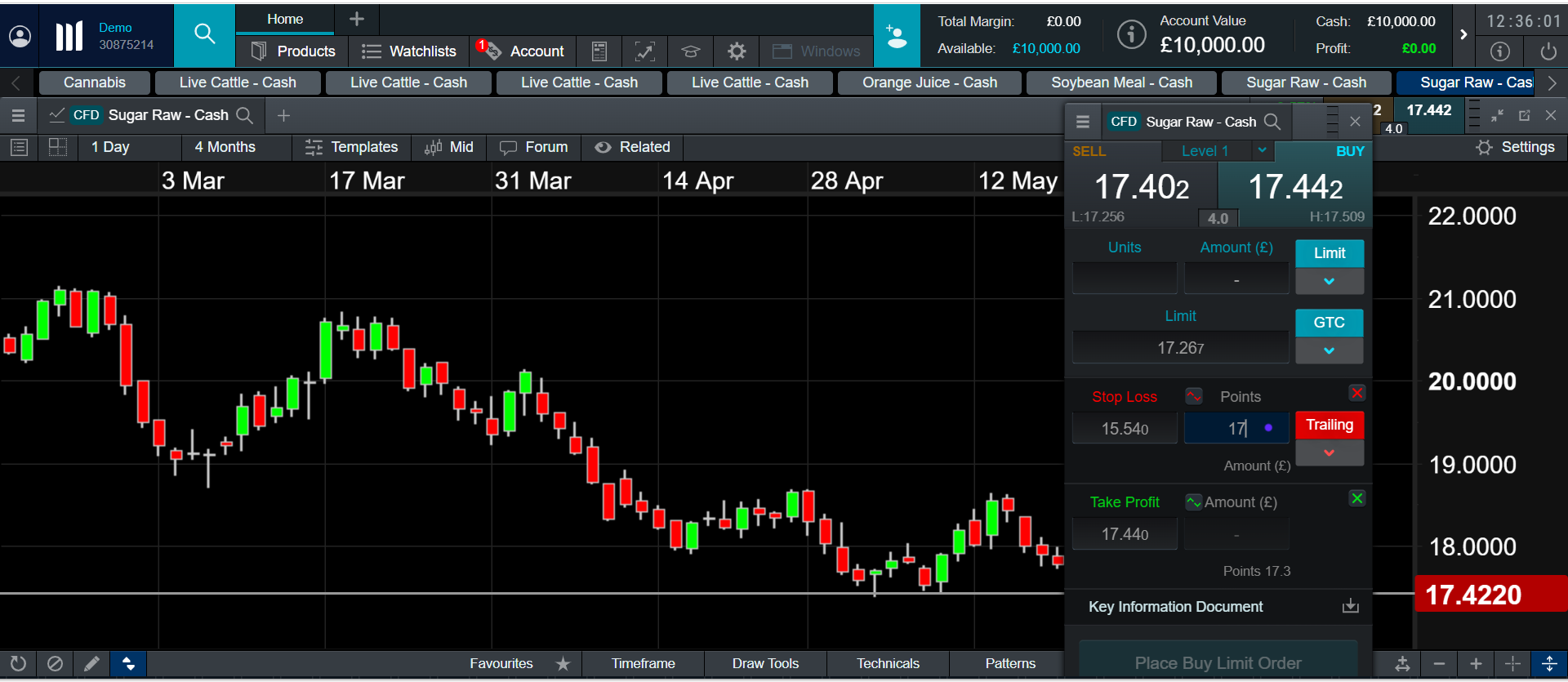Best Sugar Brokers 2025
We’ve reviewed, tested, and ranked the best sugar brokers for 2025, based on expert analysis and hands-on experience.
-
1Established in 1999, FOREX.com is part of StoneX, a global financial services company that serves over a million customers. It's regulated in the US, UK, EU, Australia, and other countries. The broker offers a wide range of markets beyond forex and provides competitive pricing on advanced platforms.
-
2
Trust Platform Assets Fees Accounts Research Education Mobile Support 3.0 InstaTrade, located in the British Virgin Islands, is an online broker that focuses on structured fixed income products and active trading via CFDs. Its no-spread accounts, outstanding research primarily from InstaTrade TV, and access to the well-known MT4 and InstaTrade Gear make it a good choice for traders of all levels. -
3
Trust Platform Assets Fees Accounts Research Education Mobile Support 3.6 Founded in 2004, Dukascopy Bank SA is a Swiss online bank and brokerage offering trading on over 1,200 instruments, including binary options. It provides various accounts (JForex, MT4/5, Binary Options) and advanced platforms (JForex, MT4/MT5) with strong tools and market data for active traders. -
4
Trust Platform Assets Fees Accounts Research Education Mobile Support 4.9 Founded in 2006, AvaTrade is a top forex and CFD broker trusted by over 400,000 traders. Regulated in 9 regions, it handles more than 2 million trades monthly. AvaTrade offers platforms like MT4, MT5, and WebTrader, with over 1,250 instruments. Traders of all levels can explore CFDs, AvaOptions, and AvaFutures for short-term trading. AvaTrade provides excellent education and 24/5 multilingual customer support for a complete trading experience. -
5
Trust Platform Assets Fees Accounts Research Education Mobile Support 4.8 IC Markets is a renowned forex and CFD broker recognized for its high-quality pricing, extensive range of trading tools, and superior trading technology. Established in 2007 in Australia, it operates under the oversight of ASIC, CySEC, and FSA. It has drawn in over 180,000 traders from across 200 countries.
Compare The Best Brokers For Trading Sugar Across Key Features
We carefully assessed leading sugar trading platforms – here’s how they compare on the factors that matter most:
How Safe Are The Top Sugar Trading Brokers?
Security is critical when trading softs like sugar. Here's how top brokers safeguard your funds:
Best Mobile Platforms For Sugar Trading
Prefer trading on the go? These mobile apps deliver fast, reliable access to sugar markets from anywhere:
Best Sugar Brokers For Beginners
Just starting out? Here’s how the top platforms make it easier to learn and trade sugar confidently:
Are These Sugar Brokers Built For Pros?
Advanced trader? Here’s how these brokers stack up on execution, analysis tools, and trading features:
Accounts Comparison
Compare the trading accounts offered by Best Sugar Brokers 2025.
Detailed Ratings: Top Brokers For Sugar Trading
Explore how the best sugar brokers scored across our comprehensive rating system:
Fees & Spreads Breakdown
We dug into pricing to reveal which sugar brokers offer tight spreads and low fees:
Which Sugar Trading Brokers Are Most Popular?
Curious where other sugar traders are going? These brokers are drawing the biggest crowds:
| Broker | Popularity |
|---|---|
| InstaTrade |
|
| FOREX.com |
|
| Dukascopy |
|
| AvaTrade |
|
| IC Markets |
|
Why Trade With FOREX.com?
FOREX.com is a top-tier brokerage suitable for forex traders of all skill levels. It offers more than 80 currency pairs, has small spreads starting from 0.0 pips, and features low fees. The platform provides powerful charting tools that include over 100 technical indicators and multiple research aids.
Pros
- FOREX.com provides top-tier forex pricing beginning at 0.0 pips. They also offer competitive cashback rebates up to 15% for dedicated traders.
- The Web Trader remains one of the top platforms for budding traders, boasting a sleek design and more than 80 technical indicators for market analysis.
- Numerous educational materials such as tutorials, webinars, and a comprehensive YouTube channel are available to assist you in learning about the financial markets.
Cons
- FOREX.com has expanded their trading offerings, but these remain limited to forex and CFDs. Unfortunately, they don't provide options to invest in actual stocks, ETFs, or cryptocurrencies.
- US clients do not have negative balance protection, so you can potentially owe more than your original account deposit.
- The funding options are not as extensive as those of top competitors such as IC Markets and lack several widely-used e-wallets, particularly UnionPay and POLi.
Why Trade With InstaTrade?
InstaTrade provides active trading on an extensive platform. It has a unique offering known as Fixed Income Structured Product (FISP), which allows for passive investment. Investors can potentially earn up to a 50% return within 6 months, provided certain conditions are fulfilled.
Pros
- InstaTrade provides a high-quality range of charting tools for traders. Its web trader includes over 250 indicators, 11 types of charts and a design that's easy to use.
- InstaTrade TV provides video interviews and insightful market information about stocks, cryptocurrencies, and more. It assists in identifying opportunities for quick trading.
- VPS hosting is suitable for algorithmic trading strategies. It uses a dedicated server to offer quick execution speeds, potentially as fast as 9 milliseconds.
Cons
- Profits in the FISP are guaranteed only if investors do not make over 50% profit and recruit other users, earning $4 for each dollar in compensation.
- InstaTrade's website and client interfaces are quite complex which can be confusing for new traders. On the other hand, XTB offers a more straightforward and user-friendly trading experience.
- The advertising of FISP, specifically about its "profit guarantee" and "risk-free trading," creates unease.
Why Trade With Dukascopy?
If you're an experienced trader, Dukascopy offers the tools you need: JForex for algorithmic strategies, competitive spreads from 0.1 pips, leverage up to 1:200, and the assurance of a Swiss-regulated bank and broker.
Pros
- The proprietary JForex platform is advanced, offering tools for algorithmic trading, detailed charting, and access to deep liquidity for traders.
- Dukascopy provides tight spreads starting at 0.1 pips, leverage up to 1:200 (based on jurisdiction), and volume-based commissions that benefit high-frequency traders.
- Dukascopy is regulated by the Swiss Financial Market Supervisory Authority (FINMA) as a broker and a bank, providing high-level financial security and compliance with strict standards.
Cons
- JForex offers many features, but its complexity makes it less ideal for beginner traders who might prefer simpler platforms.
- Dukascopy's withdrawal fees are higher than most competitors we've tested, especially for bank wire transfers, which may discourage traders who need frequent fund access.
- Dukascopy offers educational resources and 24/7 support, but its complex platforms and tools require extensive testing and can overwhelm new traders.
Why Trade With AvaTrade?
AvaTrade provides traders with essential tools: an intuitive WebTrader, strong AvaProtect risk management, a quick 5-minute sign-up, and reliable support for fast-paced markets.
Pros
- AvaTrade's support team did well in tests, responding within 3 minutes and providing local support in major regions like the UK, Europe, and the Middle East.
- Years later, AvaTrade is still among the few brokers with a custom risk management tool, AvaProtect, which insures losses up to $1M for a fee and is simple to use on the platform.
- The WebTrader performed well in our tests, featuring an easy-to-use interface for beginners and strong charting tools, including 6 chart layouts and over 60 technical indicators.
Cons
- AvaTrade’s WebTrader has improved, but it needs more customization as widgets like market watch and watchlists can't be hidden, moved, or resized.
- While the deposit process is smooth, AvaTrade doesn't support crypto payments, unlike TopFX, which caters to crypto-focused traders.
- Signing up is easy, but AvaTrade doesn't offer an ECN account like Pepperstone or IC Markets, which provides raw spreads and fast execution that many traders want.
Why Trade With IC Markets?
IC Markets provides excellent prices, quick execution, and smooth deposits. The utilization of sophisticated charting platforms such as TradingView and the Raw Trader Plus account makes it a preferred choice for intermediate to advanced traders.
Pros
- You can trade more than 2,250 CFDs in various markets, such as forex, commodities, indices, stocks, bonds, and cryptocurrencies. This range enables varied trading strategies.
- IC Markets won DayTrading.com's 'Best MT4/MT5 Broker' in 2025 for its top-notch MetaTrader integration, perfected over years to enhance the platform experience.
- IC Markets provides fast and reliable 24/5 support for account and funding issues.
Cons
- Some withdrawal methods require fees such as a $20 wire charge. This can reduce profits, particularly for traders who withdraw frequently.
- Despite having four top-tier third-party platforms, there is no in-house software or trading app specifically designed for new traders.
- The range and quality of educational materials, such as tutorials and webinars, require improvement. This lag falls behind competitors like CMC Markets and reduces its suitability for novice traders.
Filters
How We Selected the Best Sugar Brokers
To build these rankings, we focused on brokers that offer reliable access to sugar markets — whether via CFDs, futures, or other instruments linked to sugar prices.
Each provider was scored using our in-house methodology, analyzing over 200 criteria — from spreads and regulation to platform features, execution quality, and access to sugar contracts.
But we didn’t stop at specs. We placed trades to evaluate the actual user experience.

What To Look For In A Broker For Trading Sugar
After evaluating a wide range of platforms, we’ve identified what really sets the best sugar brokers apart. Here’s what to look for:
Market Access: Go Beyond Just Clicking “Buy”
If you’re serious about trading sugar, you need a broker that offers real market access, not just a shiny platform and a long list of commodities that turn out to be primarily marketing fluff. We’ve seen this firsthand when evaluating platforms ourselves. You click on “sugar” only to discover it’s just a synthetic tracker with wide spreads and limited functionality.
What you want is direct access to sugar futures, especially those listed on major global exchanges like the Chicago Mercantile Exchange (CME).
Alternatively, if you’re more into synthetic instruments, like Contracts for Difference (CFDs) or Exchange-Traded Funds (ETFs), you still want tight spreads, real-time data, and the ability to trade around the clock — not just a vague promise of “exposure to the sugar market.”
Top Pick: When it comes to sugar trading, IG delivers where it matters: deep access to both futures and CFD instruments, all in one place.
IG gives you access to sugar futures contracts listed on the Chicago Mercantile Exchange (CME), and for those trading outside traditional futures markets, they also offer CFDs tied to sugar prices – ideal for shorter-term strategies or if you’re looking to trade with leverage.
What impressed us during our testing was how smoothly IG handled both sides of the spectrum. Whether we were placing futures orders during volatile sessions or testing sugar CFDs during off-peak hours, we found execution to be quick and reliable. Add in the fact that their data feeds are substantial and include both technical and fundamental sugar market insights, and you’ve got a broker that doesn’t just offer market access — they back it up with performance.

IG web trader platform sugar CFD chart
Specific Research and Insights: Don’t Trade Blindfolded
Sugar isn’t just about price charts and candlesticks. It’s a globally traded soft commodity that reacts to a range of factors, including weather anomalies in Brazil, political shifts in India, and changes in fuel policy in Thailand. If your broker doesn’t help you keep up with that, you’re flying blindfolded.
When evaluating sugar brokers, one of the key differentiators we look for is access to in-depth research, rather than just basic market summaries. We’re talking about in-depth commodity reports, real-time analysis of supply chain disruptions, climate trends, and the kind of geopolitical insight that affects sugar output and export patterns from top producers such as Brazil, India, Thailand, and the European Union.
Unfortunately, this is where many brokers fall short. Too many simply reskin generic macroeconomic commentary and call it “research.” We’ve seen it again and again during our reviews: bland overviews with no clear focus on commodities, let alone anything specific to sugar. And that just doesn’t cut it.
Top Pick: Out of all the brokers we tested, CMC Markets stood out for its consistently detailed, commodity-specific research, especially when it comes to sugar.
CMC doesn’t just offer a daily market wrap and call it a day. Their research team actively publishes insights on soft commodities, with a clear emphasis on weather risks, supply and demand fundamentals, and macroeconomic developments in major sugar-producing countries. We found updates on El Niño’s impact on Brazil’s harvest, commentary on India’s sugar export quotas, and even analysis tied to biofuel production trends, which heavily influence sugar demand.
During our hands-on testing, we appreciated how easily we could access these insights directly within the platform. No need to dig around in external PDFs or bounce between tabs — it’s all right there, helping you make faster, more informed decisions.
Execution Speed and Reliability: Because Sugar Doesn’t Wait
If you’ve ever watched sugar markets react to a surprise United States Department of Agriculture (USDA) report or sudden export curbs out of India, you already know — every second counts.
Sugar is a volatile commodity. Prices can spike or drop in a matter of moments, especially when macroeconomic news hits or when weather events threaten key harvests in places like Brazil or Thailand.
In these conditions, a slow or unstable trading platform can wreck your position. We’ve experienced it ourselves during testing — slippage, frozen charts, delayed order confirmations — and it’s not just frustrating, it’s costly.
What you want from a broker here is simple: fast, consistent trade execution even during high-volume news events, and a stable platform that won’t buckle under pressure. Not all brokers deliver this, but one consistently did when we put them to the test.
Top Pick: When it came to execution speed and overall reliability, Pepperstone was the clear standout in our tests, especially on the cTrader Spotware platform.
We ran a series of trades during peak volatility windows — including during major USDA releases and global news headlines affecting agricultural markets — and Pepperstone delivered near-instant execution every time. Orders filled fast, with virtually no slippage on sugar CFDs, and the platform remained remarkably stable under pressure.
Pepperstone also supports low-latency infrastructure and connects to top-tier liquidity providers, which really shows when sugar prices start moving fast. Their Smart Trader Tools and advanced analytics also helped us tweak our entries and exits with precision — something that’s only possible when execution speed is there to support your strategy.

Pepperstone cTrader platform sugar CFD
Data Feeds and Charts: Your Eyes on the Sugar Market
Let’s be honest — trading sugar without live data and proper charts is like driving blindfolded. You can’t react to price moves you can’t see, and you definitely can’t time your entries or exits if your indicators are lagging.
We’ve tested sugar platforms extensively, and one of the most significant gaps we often find is around real-time data, especially for traders who want to track actual Chicago Mercantile Exchange (CME) sugar futures pricing, not just a rough CFD estimate.
Add to that the need for live global inventory numbers, export data, and technical tools explicitly built for commodities (not just generic FX overlays), and the bar gets even higher.
You’d be surprised how many brokers still limit access to delayed data or bury vital stats behind paywalls. If you want to trade sugar seriously, you need a broker that brings the complete picture into view — in real time, and without friction.
Top Pick: When it comes to real-time sugar data and pro-level charting tools, XTB gets it right. In our testing, XTB delivered real-time CME sugar pricing through their platform with no noticeable lag — a huge plus when you’re reacting to short-term volatility. They also offer detailed macro data feeds and periodic updates on global stockpiles and export flows, which are essential for anyone watching sugar supply trends.
But what stood out was the quality of their charting tools. Using the xStation platform, we had access to professional-level charts with deep customization options and technical indicators tailored to commodities. Think more than just RSI and MACD — we’re talking volume overlays that make sense for tracking seasonal trends, harvest cycles, and momentum shifts in volatile softs like sugar.
It’s also a clean, responsive interface — no clutter, no overcomplicated layouts, just fast access to the data and visuals you need to stay ahead of the curve.

XTB xStation platform sugar CFD chart
Margin and Leverage Options: Know What You’re Risking
If you’re trading sugar using futures or Contracts for Difference (CFDs), margin isn’t just a technicality — it’s a core part of your strategy. Leverage can magnify profits, yes, but it also magnifies risk. And when sugar markets get choppy (which they often do), precise, competitive, and transparent margin terms become non-negotiable.
We’ve seen brokers advertise “low margin requirements” only to bury the actual terms in fine print or shift them without warning during volatile periods. That kind of inconsistency can mess with your position sizing and risk management, especially if you’re trading across multiple soft commodities.
During our evaluations, we paid close attention to how brokers communicated leverage options, how quickly margin requirements updated in fast-moving markets, and whether risk controls (like margin call alerts or negative balance protection) were up to standard.
Top Pick: If you want transparency and flexibility when trading sugar with leverage, IC Markets is our top pick. They offer highly competitive margin terms, especially on sugar CFDs, with leverage options up to 1:200 depending on your jurisdiction and account type.
What we appreciated most during our testing was how all of this was communicated. No guessing games — margin requirements were listed, updated dynamically, and reflected market conditions in real time.
Regulatory Oversight and Broker Credibility: Trust Is the First Trade
Before you place a single sugar trade, ask yourself: Can I trust this broker? Because no matter how slick the platform looks or how tight the spreads seem, if the broker isn’t properly regulated, your capital could be at risk.
In commodities like sugar, where leveraged positions and futures contracts are common, regulation becomes even more critical. You want a broker that’s licensed by top-tier regulators — think the Financial Conduct Authority (FCA) in the United Kingdom, the Australian Securities and Investments Commission (ASIC) in Australia, or similar heavyweights — not just a checkbox from some offshore jurisdiction.
But regulation alone isn’t enough. We also look at how long the broker has been active in the commodities space, how they’ve handled volatility events in the past, and whether their customer support shows up when things go sideways.
We’ve tested all of this ourselves — from requesting support during high-volume trading windows to digging through the company’s legal history and client reviews.
Top Pick: When it comes to trust, IG consistently sets the standard. They’re regulated by the FCA in the United Kingdom, ASIC in Australia, and several other top-tier financial authorities. With over 45 years of market presence, IG has built a solid reputation for transparent operations, client fund protection, and deep experience in commodities, including sugar.
During our research, we stress-tested their platform during high-volatility events, reached out to their support team with margin-related questions, and even reviewed how they handled client communications during turbulent macroeconomic periods. The result? Consistently high marks.
Fees and Commissions: Don’t Let Costs Eat Your Profits
Sugar trading can offer big opportunities, but margins can be tight, especially if you’re scalping short moves or trading around news events. That’s why trading costs matter a lot more than most people realise. A couple of extra points in spread or a chunky commission can eat into your profits before your trade even gets going.
During our reviews, we closely compared spreads, commissions, overnight swap rates, and even hidden costs like inactivity fees. Some brokers offer zero-commission sugar trading but quietly widen the spread; others boast tight spreads but then hit you with hefty overnight charges.
Top Pick: IC Markets takes the crown here for its ultra-tight spreads and transparent fee structure. When we traded sugar CFDs through IC Markets, the spreads were among the lowest we saw, even during fast-moving sessions. They operate with a true ECN (Electronic Communication Network) model, which means you’re getting institutional-grade pricing with no dealing desk interference.
They also don’t tack on unnecessary commissions for CFD trades on sugar, and overnight financing charges were clearly stated upfront — something we always appreciate. Whether you’re swing trading or day trading sugar, low costs can make a real difference, and IC Markets keeps the playing field fair.
Risk Management Tools: Stay Sharp When Sugar Swings
If you’ve spent any time trading sugar, you know how quickly prices can move, sometimes on nothing more than a weather forecast or surprise export policy from a major producer. That kind of volatility isn’t something to fear, as long as you’re prepared.
We always evaluate what kind of risk management tools a broker offers: stop-loss orders, trailing stops, price alerts, volatility indicators, and — just as importantly — how easy those tools are to set up and adjust on the fly. Some platforms hide these features behind clunky menus or make changes take multiple clicks — not ideal when the market’s moving fast.
Top Pick: CMC Markets delivers when it comes to managing risk in fast-moving commodities like sugar. Their platform gives you intuitive access to all the essentials — stop-loss, take-profit, guaranteed stops, and customizable alerts.
We found their volatility warnings especially useful during high-risk sessions tied to USDA reports or production news from countries like India and Brazil. These real-time alerts helped us stay ahead of the market instead of reacting too late.
One thing we liked during testing: CMC’s risk settings are built into the order ticket. No need to go hunting through settings or open a new screen just to protect your trade — it’s all right there, easy to adjust, even mid-trade.

CMC Markets platform sugar CFD order ticket




